Effectiveness of Face Recognition Technology in iPhone Data Protection
VerifiedAdded on 2023/03/23
|12
|3147
|84
AI Summary
This research study focuses on the effectiveness of face recognition technology in iPhone data protection. It explores the working functions of the technology, security issues, and measures to protect data. The study aims to analyze the relevance and scope of the subject.
Contribute Materials
Your contribution can guide someone’s learning journey. Share your
documents today.
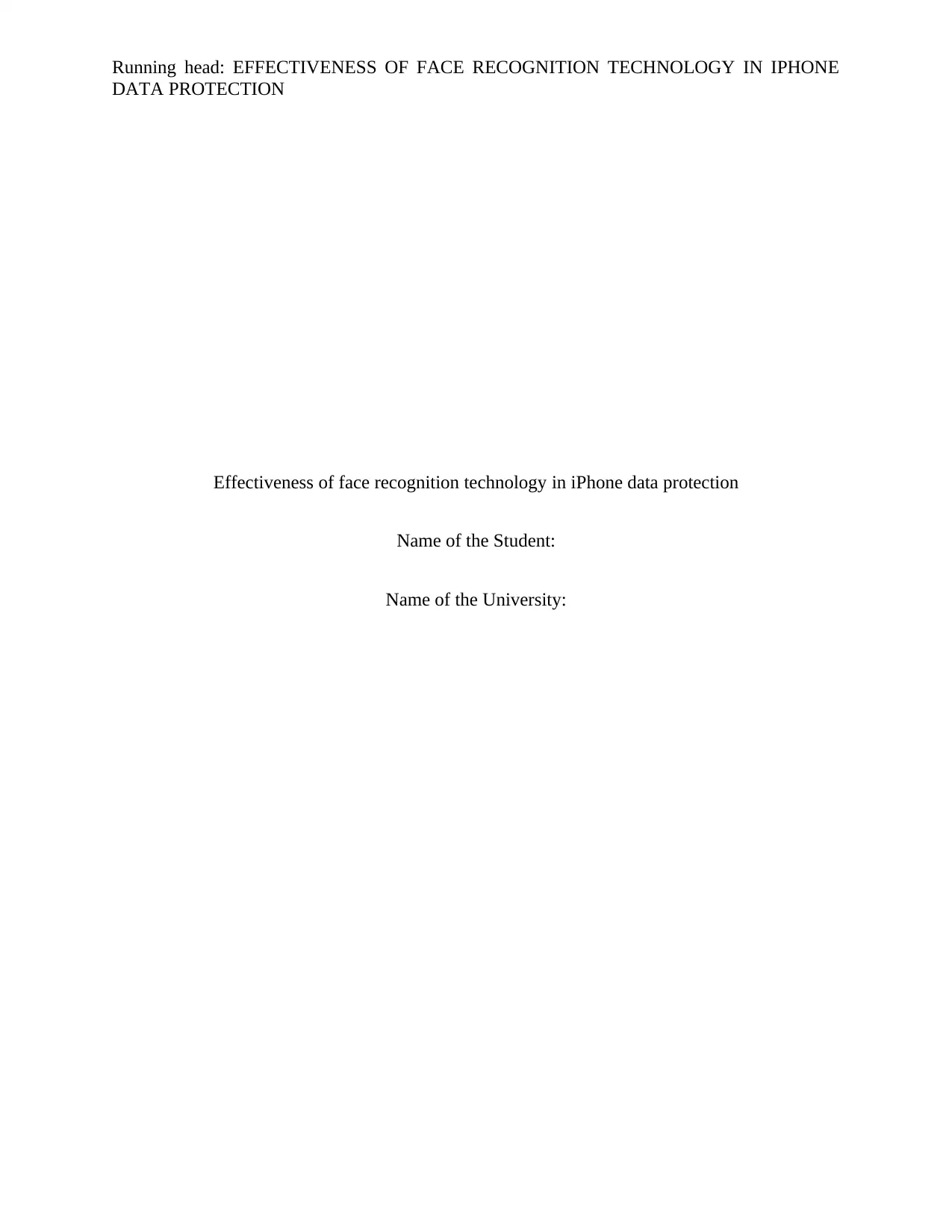
Running head: EFFECTIVENESS OF FACE RECOGNITION TECHNOLOGY IN IPHONE
DATA PROTECTION
Effectiveness of face recognition technology in iPhone data protection
Name of the Student:
Name of the University:
DATA PROTECTION
Effectiveness of face recognition technology in iPhone data protection
Name of the Student:
Name of the University:
Secure Best Marks with AI Grader
Need help grading? Try our AI Grader for instant feedback on your assignments.
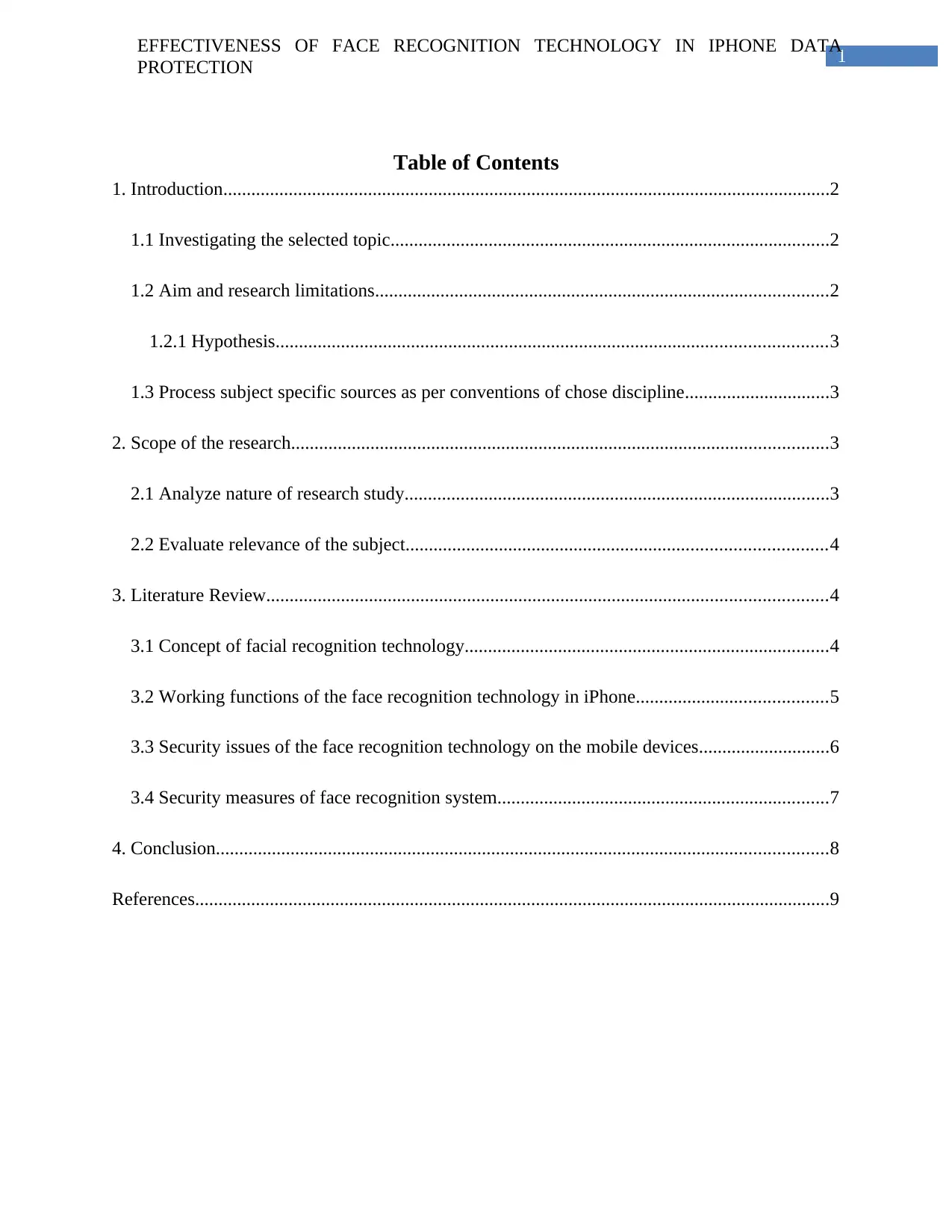
1
EFFECTIVENESS OF FACE RECOGNITION TECHNOLOGY IN IPHONE DATA
PROTECTION
Table of Contents
1. Introduction..................................................................................................................................2
1.1 Investigating the selected topic..............................................................................................2
1.2 Aim and research limitations.................................................................................................2
1.2.1 Hypothesis......................................................................................................................3
1.3 Process subject specific sources as per conventions of chose discipline...............................3
2. Scope of the research...................................................................................................................3
2.1 Analyze nature of research study...........................................................................................3
2.2 Evaluate relevance of the subject..........................................................................................4
3. Literature Review........................................................................................................................4
3.1 Concept of facial recognition technology..............................................................................4
3.2 Working functions of the face recognition technology in iPhone.........................................5
3.3 Security issues of the face recognition technology on the mobile devices............................6
3.4 Security measures of face recognition system.......................................................................7
4. Conclusion...................................................................................................................................8
References........................................................................................................................................9
EFFECTIVENESS OF FACE RECOGNITION TECHNOLOGY IN IPHONE DATA
PROTECTION
Table of Contents
1. Introduction..................................................................................................................................2
1.1 Investigating the selected topic..............................................................................................2
1.2 Aim and research limitations.................................................................................................2
1.2.1 Hypothesis......................................................................................................................3
1.3 Process subject specific sources as per conventions of chose discipline...............................3
2. Scope of the research...................................................................................................................3
2.1 Analyze nature of research study...........................................................................................3
2.2 Evaluate relevance of the subject..........................................................................................4
3. Literature Review........................................................................................................................4
3.1 Concept of facial recognition technology..............................................................................4
3.2 Working functions of the face recognition technology in iPhone.........................................5
3.3 Security issues of the face recognition technology on the mobile devices............................6
3.4 Security measures of face recognition system.......................................................................7
4. Conclusion...................................................................................................................................8
References........................................................................................................................................9
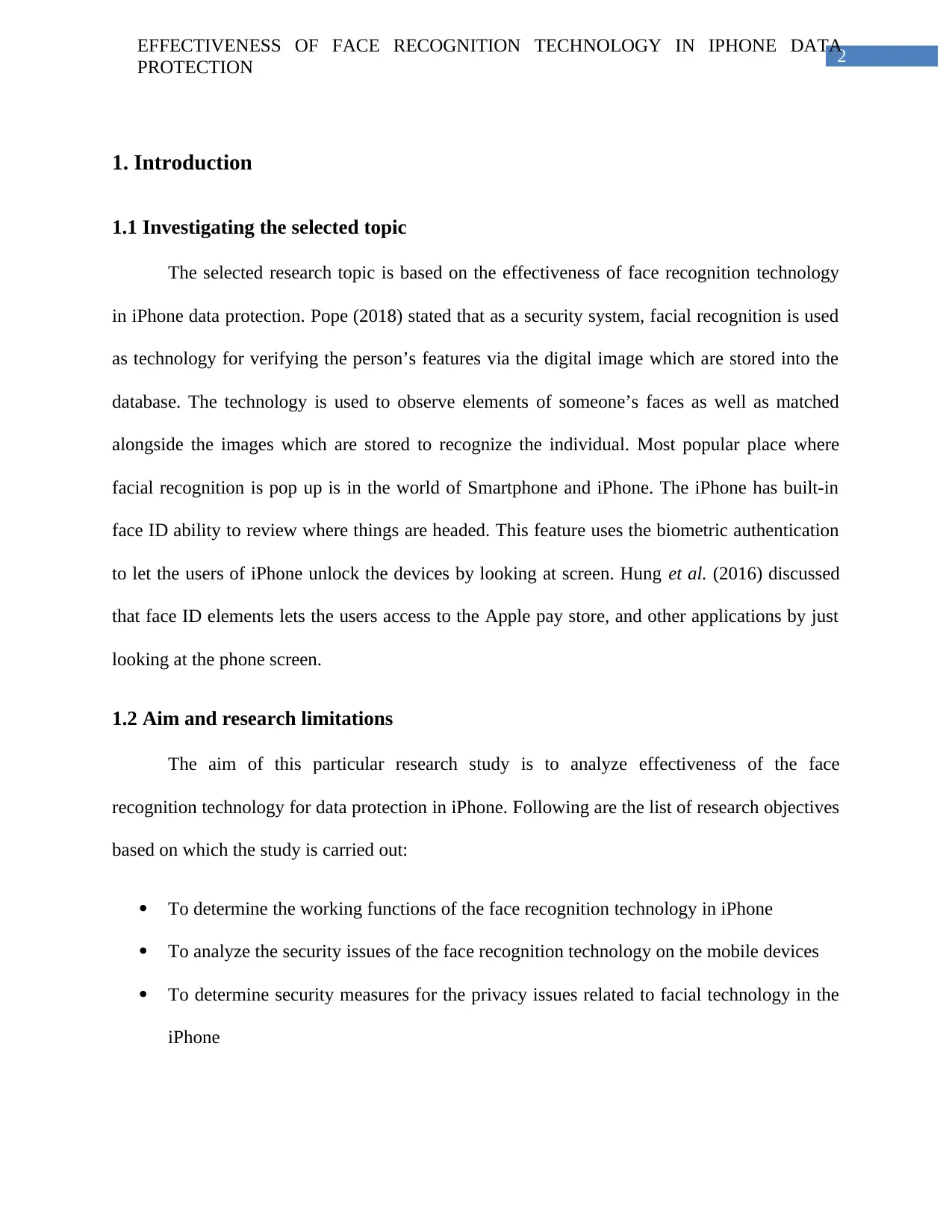
2
EFFECTIVENESS OF FACE RECOGNITION TECHNOLOGY IN IPHONE DATA
PROTECTION
1. Introduction
1.1 Investigating the selected topic
The selected research topic is based on the effectiveness of face recognition technology
in iPhone data protection. Pope (2018) stated that as a security system, facial recognition is used
as technology for verifying the person’s features via the digital image which are stored into the
database. The technology is used to observe elements of someone’s faces as well as matched
alongside the images which are stored to recognize the individual. Most popular place where
facial recognition is pop up is in the world of Smartphone and iPhone. The iPhone has built-in
face ID ability to review where things are headed. This feature uses the biometric authentication
to let the users of iPhone unlock the devices by looking at screen. Hung et al. (2016) discussed
that face ID elements lets the users access to the Apple pay store, and other applications by just
looking at the phone screen.
1.2 Aim and research limitations
The aim of this particular research study is to analyze effectiveness of the face
recognition technology for data protection in iPhone. Following are the list of research objectives
based on which the study is carried out:
To determine the working functions of the face recognition technology in iPhone
To analyze the security issues of the face recognition technology on the mobile devices
To determine security measures for the privacy issues related to facial technology in the
iPhone
EFFECTIVENESS OF FACE RECOGNITION TECHNOLOGY IN IPHONE DATA
PROTECTION
1. Introduction
1.1 Investigating the selected topic
The selected research topic is based on the effectiveness of face recognition technology
in iPhone data protection. Pope (2018) stated that as a security system, facial recognition is used
as technology for verifying the person’s features via the digital image which are stored into the
database. The technology is used to observe elements of someone’s faces as well as matched
alongside the images which are stored to recognize the individual. Most popular place where
facial recognition is pop up is in the world of Smartphone and iPhone. The iPhone has built-in
face ID ability to review where things are headed. This feature uses the biometric authentication
to let the users of iPhone unlock the devices by looking at screen. Hung et al. (2016) discussed
that face ID elements lets the users access to the Apple pay store, and other applications by just
looking at the phone screen.
1.2 Aim and research limitations
The aim of this particular research study is to analyze effectiveness of the face
recognition technology for data protection in iPhone. Following are the list of research objectives
based on which the study is carried out:
To determine the working functions of the face recognition technology in iPhone
To analyze the security issues of the face recognition technology on the mobile devices
To determine security measures for the privacy issues related to facial technology in the
iPhone
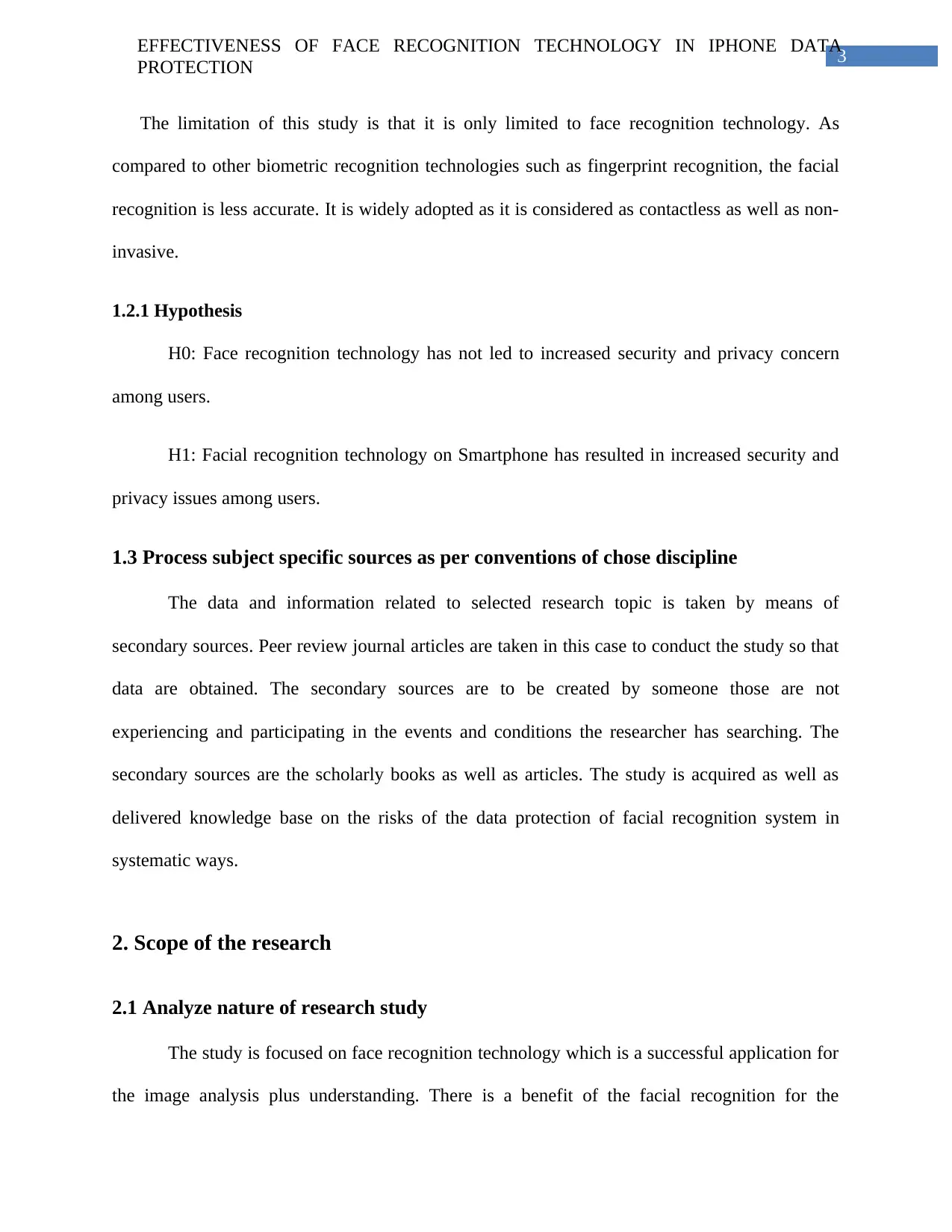
3
EFFECTIVENESS OF FACE RECOGNITION TECHNOLOGY IN IPHONE DATA
PROTECTION
The limitation of this study is that it is only limited to face recognition technology. As
compared to other biometric recognition technologies such as fingerprint recognition, the facial
recognition is less accurate. It is widely adopted as it is considered as contactless as well as non-
invasive.
1.2.1 Hypothesis
H0: Face recognition technology has not led to increased security and privacy concern
among users.
H1: Facial recognition technology on Smartphone has resulted in increased security and
privacy issues among users.
1.3 Process subject specific sources as per conventions of chose discipline
The data and information related to selected research topic is taken by means of
secondary sources. Peer review journal articles are taken in this case to conduct the study so that
data are obtained. The secondary sources are to be created by someone those are not
experiencing and participating in the events and conditions the researcher has searching. The
secondary sources are the scholarly books as well as articles. The study is acquired as well as
delivered knowledge base on the risks of the data protection of facial recognition system in
systematic ways.
2. Scope of the research
2.1 Analyze nature of research study
The study is focused on face recognition technology which is a successful application for
the image analysis plus understanding. There is a benefit of the facial recognition for the
EFFECTIVENESS OF FACE RECOGNITION TECHNOLOGY IN IPHONE DATA
PROTECTION
The limitation of this study is that it is only limited to face recognition technology. As
compared to other biometric recognition technologies such as fingerprint recognition, the facial
recognition is less accurate. It is widely adopted as it is considered as contactless as well as non-
invasive.
1.2.1 Hypothesis
H0: Face recognition technology has not led to increased security and privacy concern
among users.
H1: Facial recognition technology on Smartphone has resulted in increased security and
privacy issues among users.
1.3 Process subject specific sources as per conventions of chose discipline
The data and information related to selected research topic is taken by means of
secondary sources. Peer review journal articles are taken in this case to conduct the study so that
data are obtained. The secondary sources are to be created by someone those are not
experiencing and participating in the events and conditions the researcher has searching. The
secondary sources are the scholarly books as well as articles. The study is acquired as well as
delivered knowledge base on the risks of the data protection of facial recognition system in
systematic ways.
2. Scope of the research
2.1 Analyze nature of research study
The study is focused on face recognition technology which is a successful application for
the image analysis plus understanding. There is a benefit of the facial recognition for the
Secure Best Marks with AI Grader
Need help grading? Try our AI Grader for instant feedback on your assignments.
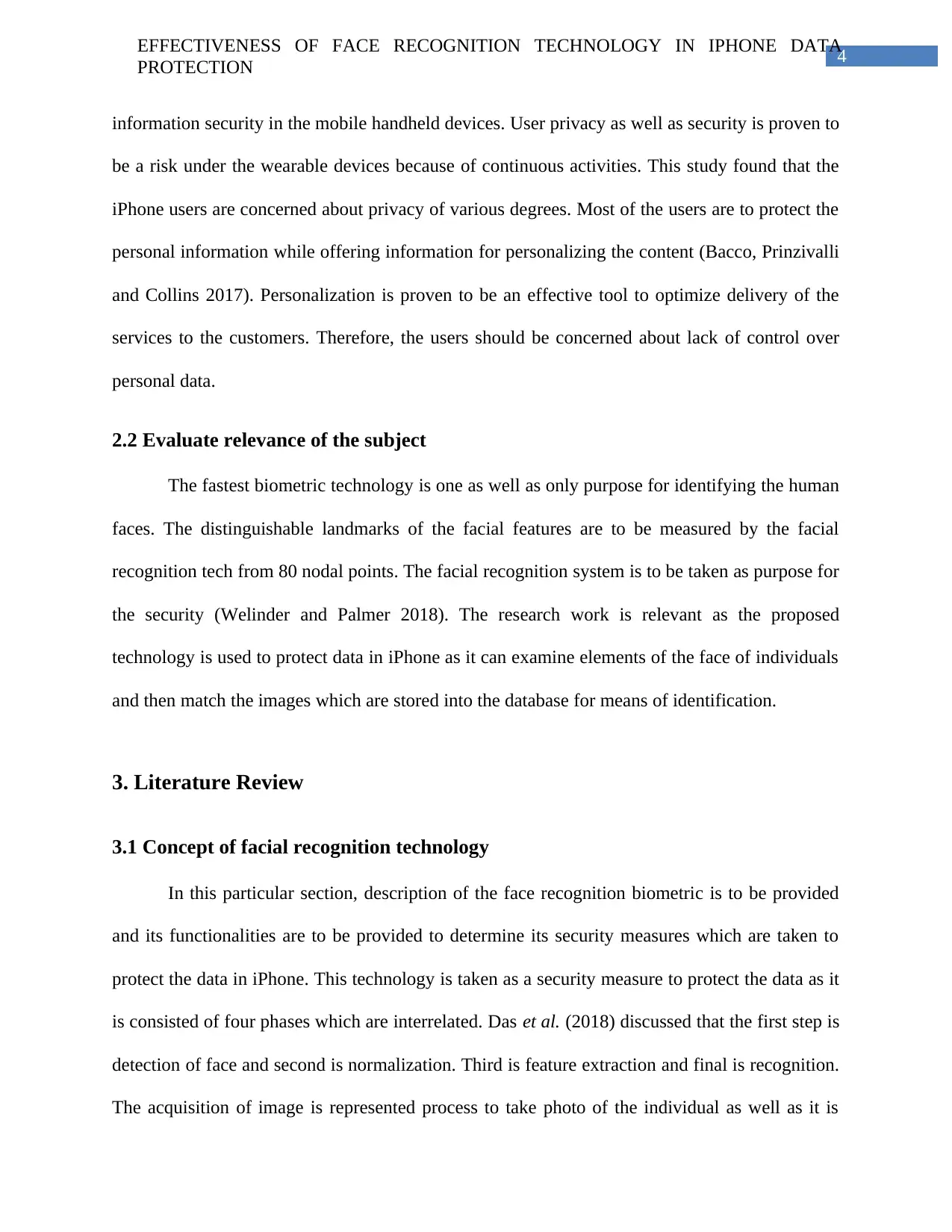
4
EFFECTIVENESS OF FACE RECOGNITION TECHNOLOGY IN IPHONE DATA
PROTECTION
information security in the mobile handheld devices. User privacy as well as security is proven to
be a risk under the wearable devices because of continuous activities. This study found that the
iPhone users are concerned about privacy of various degrees. Most of the users are to protect the
personal information while offering information for personalizing the content (Bacco, Prinzivalli
and Collins 2017). Personalization is proven to be an effective tool to optimize delivery of the
services to the customers. Therefore, the users should be concerned about lack of control over
personal data.
2.2 Evaluate relevance of the subject
The fastest biometric technology is one as well as only purpose for identifying the human
faces. The distinguishable landmarks of the facial features are to be measured by the facial
recognition tech from 80 nodal points. The facial recognition system is to be taken as purpose for
the security (Welinder and Palmer 2018). The research work is relevant as the proposed
technology is used to protect data in iPhone as it can examine elements of the face of individuals
and then match the images which are stored into the database for means of identification.
3. Literature Review
3.1 Concept of facial recognition technology
In this particular section, description of the face recognition biometric is to be provided
and its functionalities are to be provided to determine its security measures which are taken to
protect the data in iPhone. This technology is taken as a security measure to protect the data as it
is consisted of four phases which are interrelated. Das et al. (2018) discussed that the first step is
detection of face and second is normalization. Third is feature extraction and final is recognition.
The acquisition of image is represented process to take photo of the individual as well as it is
EFFECTIVENESS OF FACE RECOGNITION TECHNOLOGY IN IPHONE DATA
PROTECTION
information security in the mobile handheld devices. User privacy as well as security is proven to
be a risk under the wearable devices because of continuous activities. This study found that the
iPhone users are concerned about privacy of various degrees. Most of the users are to protect the
personal information while offering information for personalizing the content (Bacco, Prinzivalli
and Collins 2017). Personalization is proven to be an effective tool to optimize delivery of the
services to the customers. Therefore, the users should be concerned about lack of control over
personal data.
2.2 Evaluate relevance of the subject
The fastest biometric technology is one as well as only purpose for identifying the human
faces. The distinguishable landmarks of the facial features are to be measured by the facial
recognition tech from 80 nodal points. The facial recognition system is to be taken as purpose for
the security (Welinder and Palmer 2018). The research work is relevant as the proposed
technology is used to protect data in iPhone as it can examine elements of the face of individuals
and then match the images which are stored into the database for means of identification.
3. Literature Review
3.1 Concept of facial recognition technology
In this particular section, description of the face recognition biometric is to be provided
and its functionalities are to be provided to determine its security measures which are taken to
protect the data in iPhone. This technology is taken as a security measure to protect the data as it
is consisted of four phases which are interrelated. Das et al. (2018) discussed that the first step is
detection of face and second is normalization. Third is feature extraction and final is recognition.
The acquisition of image is represented process to take photo of the individual as well as it is
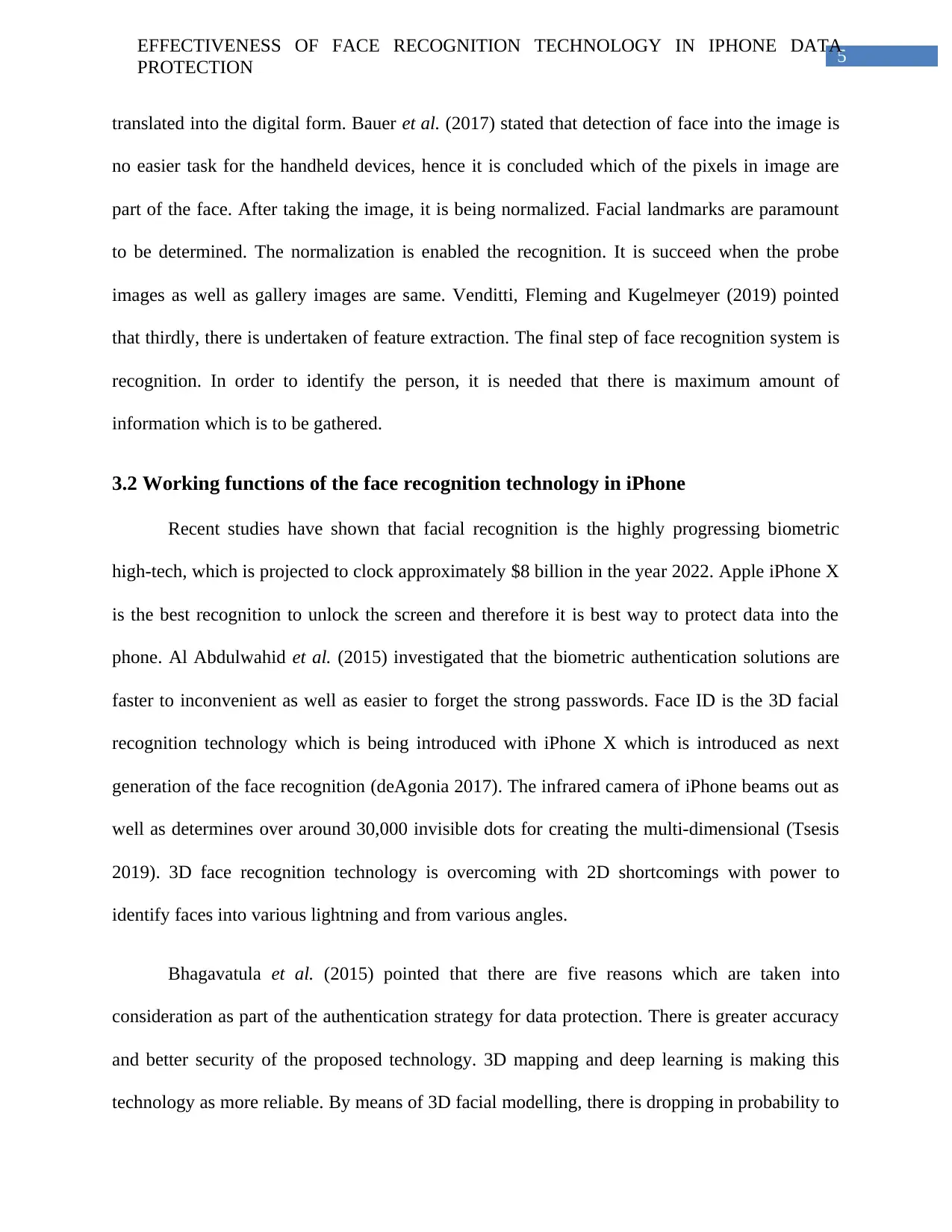
5
EFFECTIVENESS OF FACE RECOGNITION TECHNOLOGY IN IPHONE DATA
PROTECTION
translated into the digital form. Bauer et al. (2017) stated that detection of face into the image is
no easier task for the handheld devices, hence it is concluded which of the pixels in image are
part of the face. After taking the image, it is being normalized. Facial landmarks are paramount
to be determined. The normalization is enabled the recognition. It is succeed when the probe
images as well as gallery images are same. Venditti, Fleming and Kugelmeyer (2019) pointed
that thirdly, there is undertaken of feature extraction. The final step of face recognition system is
recognition. In order to identify the person, it is needed that there is maximum amount of
information which is to be gathered.
3.2 Working functions of the face recognition technology in iPhone
Recent studies have shown that facial recognition is the highly progressing biometric
high-tech, which is projected to clock approximately $8 billion in the year 2022. Apple iPhone X
is the best recognition to unlock the screen and therefore it is best way to protect data into the
phone. Al Abdulwahid et al. (2015) investigated that the biometric authentication solutions are
faster to inconvenient as well as easier to forget the strong passwords. Face ID is the 3D facial
recognition technology which is being introduced with iPhone X which is introduced as next
generation of the face recognition (deAgonia 2017). The infrared camera of iPhone beams out as
well as determines over around 30,000 invisible dots for creating the multi-dimensional (Tsesis
2019). 3D face recognition technology is overcoming with 2D shortcomings with power to
identify faces into various lightning and from various angles.
Bhagavatula et al. (2015) pointed that there are five reasons which are taken into
consideration as part of the authentication strategy for data protection. There is greater accuracy
and better security of the proposed technology. 3D mapping and deep learning is making this
technology as more reliable. By means of 3D facial modelling, there is dropping in probability to
EFFECTIVENESS OF FACE RECOGNITION TECHNOLOGY IN IPHONE DATA
PROTECTION
translated into the digital form. Bauer et al. (2017) stated that detection of face into the image is
no easier task for the handheld devices, hence it is concluded which of the pixels in image are
part of the face. After taking the image, it is being normalized. Facial landmarks are paramount
to be determined. The normalization is enabled the recognition. It is succeed when the probe
images as well as gallery images are same. Venditti, Fleming and Kugelmeyer (2019) pointed
that thirdly, there is undertaken of feature extraction. The final step of face recognition system is
recognition. In order to identify the person, it is needed that there is maximum amount of
information which is to be gathered.
3.2 Working functions of the face recognition technology in iPhone
Recent studies have shown that facial recognition is the highly progressing biometric
high-tech, which is projected to clock approximately $8 billion in the year 2022. Apple iPhone X
is the best recognition to unlock the screen and therefore it is best way to protect data into the
phone. Al Abdulwahid et al. (2015) investigated that the biometric authentication solutions are
faster to inconvenient as well as easier to forget the strong passwords. Face ID is the 3D facial
recognition technology which is being introduced with iPhone X which is introduced as next
generation of the face recognition (deAgonia 2017). The infrared camera of iPhone beams out as
well as determines over around 30,000 invisible dots for creating the multi-dimensional (Tsesis
2019). 3D face recognition technology is overcoming with 2D shortcomings with power to
identify faces into various lightning and from various angles.
Bhagavatula et al. (2015) pointed that there are five reasons which are taken into
consideration as part of the authentication strategy for data protection. There is greater accuracy
and better security of the proposed technology. 3D mapping and deep learning is making this
technology as more reliable. By means of 3D facial modelling, there is dropping in probability to
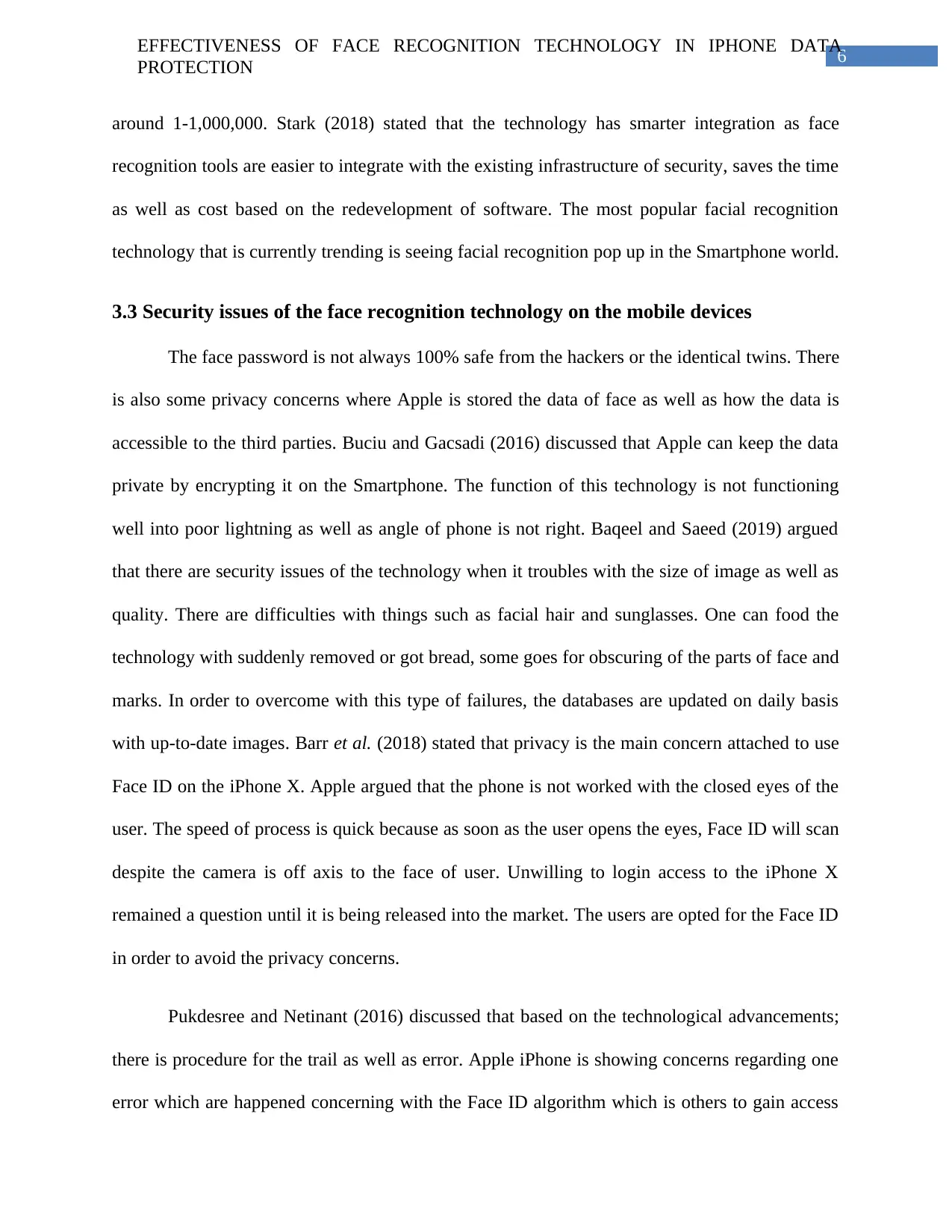
6
EFFECTIVENESS OF FACE RECOGNITION TECHNOLOGY IN IPHONE DATA
PROTECTION
around 1-1,000,000. Stark (2018) stated that the technology has smarter integration as face
recognition tools are easier to integrate with the existing infrastructure of security, saves the time
as well as cost based on the redevelopment of software. The most popular facial recognition
technology that is currently trending is seeing facial recognition pop up in the Smartphone world.
3.3 Security issues of the face recognition technology on the mobile devices
The face password is not always 100% safe from the hackers or the identical twins. There
is also some privacy concerns where Apple is stored the data of face as well as how the data is
accessible to the third parties. Buciu and Gacsadi (2016) discussed that Apple can keep the data
private by encrypting it on the Smartphone. The function of this technology is not functioning
well into poor lightning as well as angle of phone is not right. Baqeel and Saeed (2019) argued
that there are security issues of the technology when it troubles with the size of image as well as
quality. There are difficulties with things such as facial hair and sunglasses. One can food the
technology with suddenly removed or got bread, some goes for obscuring of the parts of face and
marks. In order to overcome with this type of failures, the databases are updated on daily basis
with up-to-date images. Barr et al. (2018) stated that privacy is the main concern attached to use
Face ID on the iPhone X. Apple argued that the phone is not worked with the closed eyes of the
user. The speed of process is quick because as soon as the user opens the eyes, Face ID will scan
despite the camera is off axis to the face of user. Unwilling to login access to the iPhone X
remained a question until it is being released into the market. The users are opted for the Face ID
in order to avoid the privacy concerns.
Pukdesree and Netinant (2016) discussed that based on the technological advancements;
there is procedure for the trail as well as error. Apple iPhone is showing concerns regarding one
error which are happened concerning with the Face ID algorithm which is others to gain access
EFFECTIVENESS OF FACE RECOGNITION TECHNOLOGY IN IPHONE DATA
PROTECTION
around 1-1,000,000. Stark (2018) stated that the technology has smarter integration as face
recognition tools are easier to integrate with the existing infrastructure of security, saves the time
as well as cost based on the redevelopment of software. The most popular facial recognition
technology that is currently trending is seeing facial recognition pop up in the Smartphone world.
3.3 Security issues of the face recognition technology on the mobile devices
The face password is not always 100% safe from the hackers or the identical twins. There
is also some privacy concerns where Apple is stored the data of face as well as how the data is
accessible to the third parties. Buciu and Gacsadi (2016) discussed that Apple can keep the data
private by encrypting it on the Smartphone. The function of this technology is not functioning
well into poor lightning as well as angle of phone is not right. Baqeel and Saeed (2019) argued
that there are security issues of the technology when it troubles with the size of image as well as
quality. There are difficulties with things such as facial hair and sunglasses. One can food the
technology with suddenly removed or got bread, some goes for obscuring of the parts of face and
marks. In order to overcome with this type of failures, the databases are updated on daily basis
with up-to-date images. Barr et al. (2018) stated that privacy is the main concern attached to use
Face ID on the iPhone X. Apple argued that the phone is not worked with the closed eyes of the
user. The speed of process is quick because as soon as the user opens the eyes, Face ID will scan
despite the camera is off axis to the face of user. Unwilling to login access to the iPhone X
remained a question until it is being released into the market. The users are opted for the Face ID
in order to avoid the privacy concerns.
Pukdesree and Netinant (2016) discussed that based on the technological advancements;
there is procedure for the trail as well as error. Apple iPhone is showing concerns regarding one
error which are happened concerning with the Face ID algorithm which is others to gain access
Paraphrase This Document
Need a fresh take? Get an instant paraphrase of this document with our AI Paraphraser
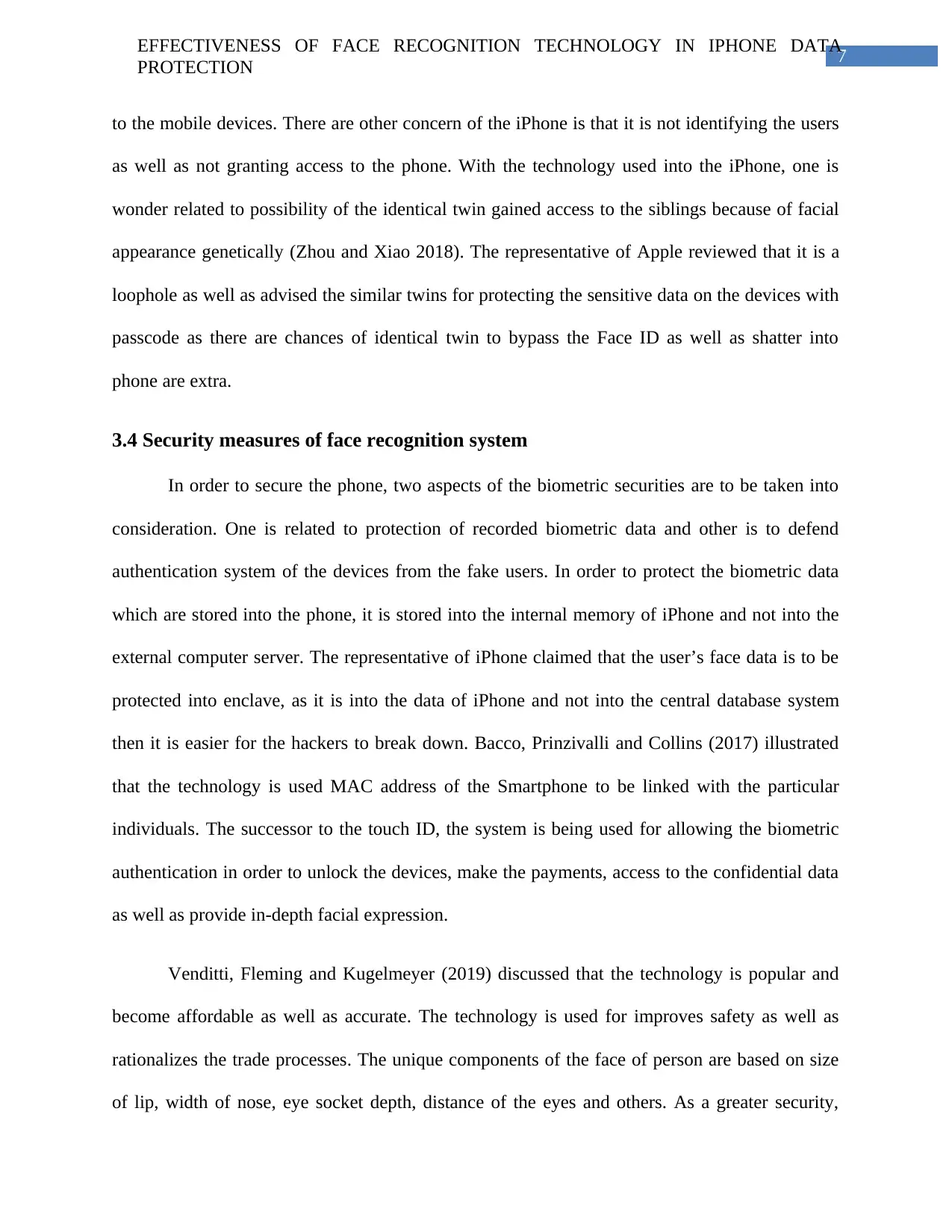
7
EFFECTIVENESS OF FACE RECOGNITION TECHNOLOGY IN IPHONE DATA
PROTECTION
to the mobile devices. There are other concern of the iPhone is that it is not identifying the users
as well as not granting access to the phone. With the technology used into the iPhone, one is
wonder related to possibility of the identical twin gained access to the siblings because of facial
appearance genetically (Zhou and Xiao 2018). The representative of Apple reviewed that it is a
loophole as well as advised the similar twins for protecting the sensitive data on the devices with
passcode as there are chances of identical twin to bypass the Face ID as well as shatter into
phone are extra.
3.4 Security measures of face recognition system
In order to secure the phone, two aspects of the biometric securities are to be taken into
consideration. One is related to protection of recorded biometric data and other is to defend
authentication system of the devices from the fake users. In order to protect the biometric data
which are stored into the phone, it is stored into the internal memory of iPhone and not into the
external computer server. The representative of iPhone claimed that the user’s face data is to be
protected into enclave, as it is into the data of iPhone and not into the central database system
then it is easier for the hackers to break down. Bacco, Prinzivalli and Collins (2017) illustrated
that the technology is used MAC address of the Smartphone to be linked with the particular
individuals. The successor to the touch ID, the system is being used for allowing the biometric
authentication in order to unlock the devices, make the payments, access to the confidential data
as well as provide in-depth facial expression.
Venditti, Fleming and Kugelmeyer (2019) discussed that the technology is popular and
become affordable as well as accurate. The technology is used for improves safety as well as
rationalizes the trade processes. The unique components of the face of person are based on size
of lip, width of nose, eye socket depth, distance of the eyes and others. As a greater security,
EFFECTIVENESS OF FACE RECOGNITION TECHNOLOGY IN IPHONE DATA
PROTECTION
to the mobile devices. There are other concern of the iPhone is that it is not identifying the users
as well as not granting access to the phone. With the technology used into the iPhone, one is
wonder related to possibility of the identical twin gained access to the siblings because of facial
appearance genetically (Zhou and Xiao 2018). The representative of Apple reviewed that it is a
loophole as well as advised the similar twins for protecting the sensitive data on the devices with
passcode as there are chances of identical twin to bypass the Face ID as well as shatter into
phone are extra.
3.4 Security measures of face recognition system
In order to secure the phone, two aspects of the biometric securities are to be taken into
consideration. One is related to protection of recorded biometric data and other is to defend
authentication system of the devices from the fake users. In order to protect the biometric data
which are stored into the phone, it is stored into the internal memory of iPhone and not into the
external computer server. The representative of iPhone claimed that the user’s face data is to be
protected into enclave, as it is into the data of iPhone and not into the central database system
then it is easier for the hackers to break down. Bacco, Prinzivalli and Collins (2017) illustrated
that the technology is used MAC address of the Smartphone to be linked with the particular
individuals. The successor to the touch ID, the system is being used for allowing the biometric
authentication in order to unlock the devices, make the payments, access to the confidential data
as well as provide in-depth facial expression.
Venditti, Fleming and Kugelmeyer (2019) discussed that the technology is popular and
become affordable as well as accurate. The technology is used for improves safety as well as
rationalizes the trade processes. The unique components of the face of person are based on size
of lip, width of nose, eye socket depth, distance of the eyes and others. As a greater security,
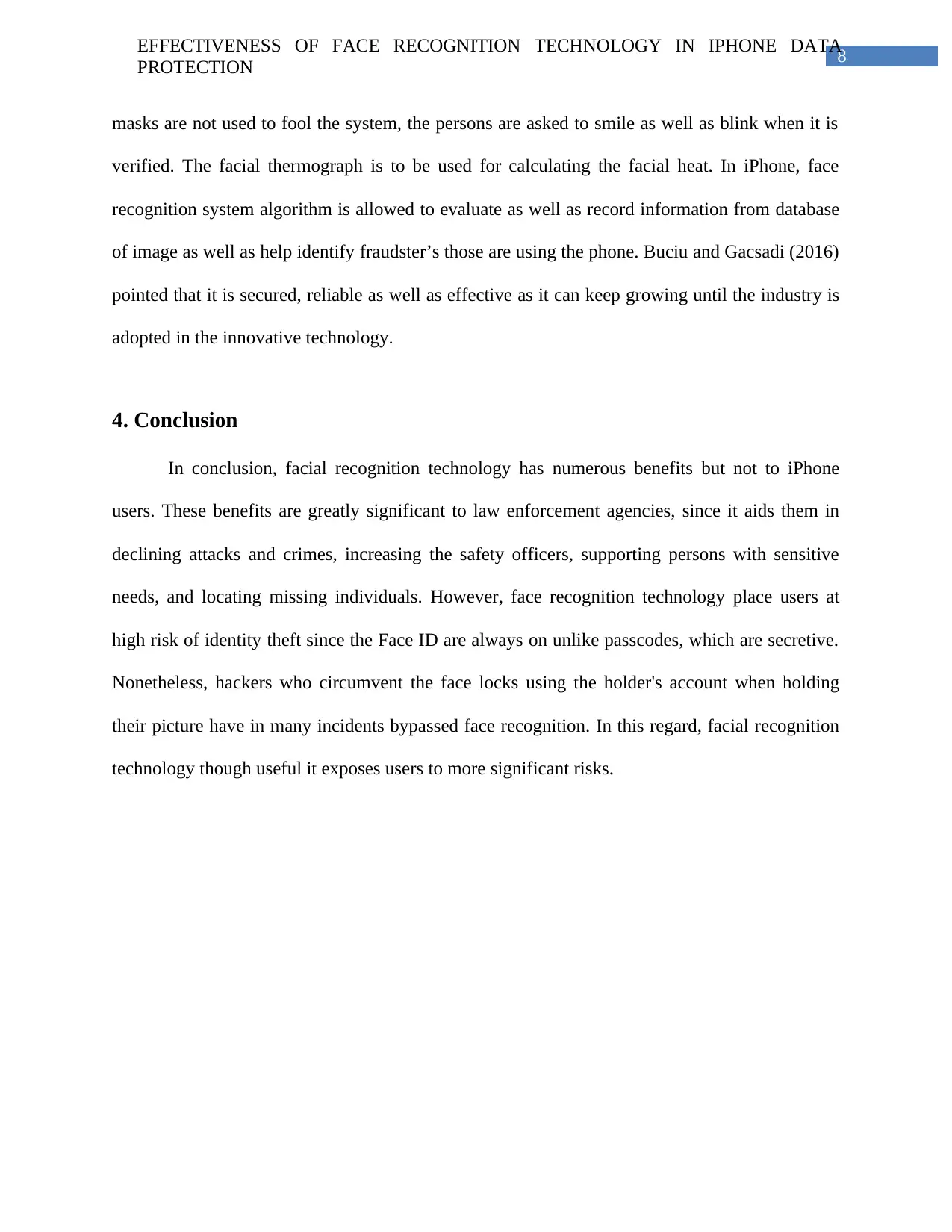
8
EFFECTIVENESS OF FACE RECOGNITION TECHNOLOGY IN IPHONE DATA
PROTECTION
masks are not used to fool the system, the persons are asked to smile as well as blink when it is
verified. The facial thermograph is to be used for calculating the facial heat. In iPhone, face
recognition system algorithm is allowed to evaluate as well as record information from database
of image as well as help identify fraudster’s those are using the phone. Buciu and Gacsadi (2016)
pointed that it is secured, reliable as well as effective as it can keep growing until the industry is
adopted in the innovative technology.
4. Conclusion
In conclusion, facial recognition technology has numerous benefits but not to iPhone
users. These benefits are greatly significant to law enforcement agencies, since it aids them in
declining attacks and crimes, increasing the safety officers, supporting persons with sensitive
needs, and locating missing individuals. However, face recognition technology place users at
high risk of identity theft since the Face ID are always on unlike passcodes, which are secretive.
Nonetheless, hackers who circumvent the face locks using the holder's account when holding
their picture have in many incidents bypassed face recognition. In this regard, facial recognition
technology though useful it exposes users to more significant risks.
EFFECTIVENESS OF FACE RECOGNITION TECHNOLOGY IN IPHONE DATA
PROTECTION
masks are not used to fool the system, the persons are asked to smile as well as blink when it is
verified. The facial thermograph is to be used for calculating the facial heat. In iPhone, face
recognition system algorithm is allowed to evaluate as well as record information from database
of image as well as help identify fraudster’s those are using the phone. Buciu and Gacsadi (2016)
pointed that it is secured, reliable as well as effective as it can keep growing until the industry is
adopted in the innovative technology.
4. Conclusion
In conclusion, facial recognition technology has numerous benefits but not to iPhone
users. These benefits are greatly significant to law enforcement agencies, since it aids them in
declining attacks and crimes, increasing the safety officers, supporting persons with sensitive
needs, and locating missing individuals. However, face recognition technology place users at
high risk of identity theft since the Face ID are always on unlike passcodes, which are secretive.
Nonetheless, hackers who circumvent the face locks using the holder's account when holding
their picture have in many incidents bypassed face recognition. In this regard, facial recognition
technology though useful it exposes users to more significant risks.
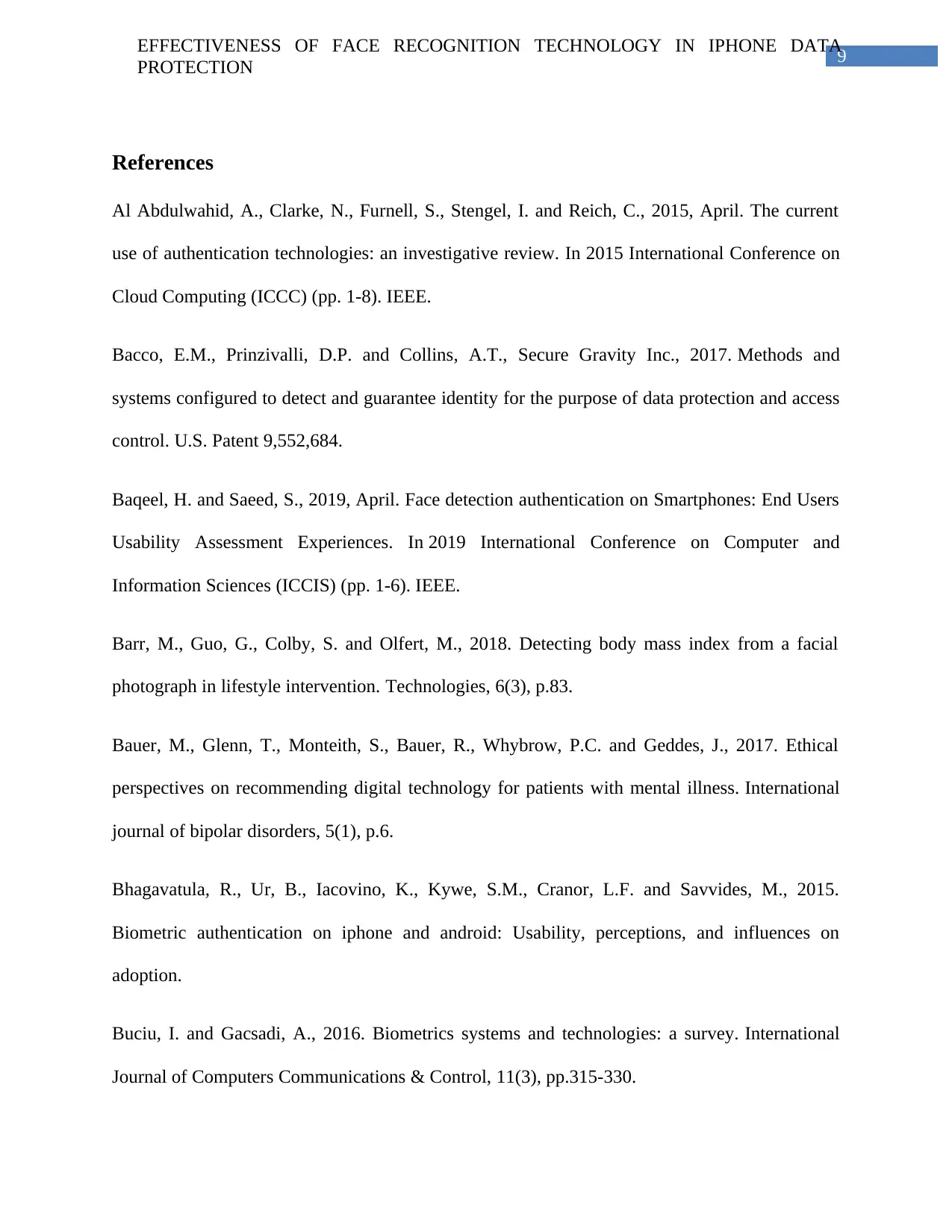
9
EFFECTIVENESS OF FACE RECOGNITION TECHNOLOGY IN IPHONE DATA
PROTECTION
References
Al Abdulwahid, A., Clarke, N., Furnell, S., Stengel, I. and Reich, C., 2015, April. The current
use of authentication technologies: an investigative review. In 2015 International Conference on
Cloud Computing (ICCC) (pp. 1-8). IEEE.
Bacco, E.M., Prinzivalli, D.P. and Collins, A.T., Secure Gravity Inc., 2017. Methods and
systems configured to detect and guarantee identity for the purpose of data protection and access
control. U.S. Patent 9,552,684.
Baqeel, H. and Saeed, S., 2019, April. Face detection authentication on Smartphones: End Users
Usability Assessment Experiences. In 2019 International Conference on Computer and
Information Sciences (ICCIS) (pp. 1-6). IEEE.
Barr, M., Guo, G., Colby, S. and Olfert, M., 2018. Detecting body mass index from a facial
photograph in lifestyle intervention. Technologies, 6(3), p.83.
Bauer, M., Glenn, T., Monteith, S., Bauer, R., Whybrow, P.C. and Geddes, J., 2017. Ethical
perspectives on recommending digital technology for patients with mental illness. International
journal of bipolar disorders, 5(1), p.6.
Bhagavatula, R., Ur, B., Iacovino, K., Kywe, S.M., Cranor, L.F. and Savvides, M., 2015.
Biometric authentication on iphone and android: Usability, perceptions, and influences on
adoption.
Buciu, I. and Gacsadi, A., 2016. Biometrics systems and technologies: a survey. International
Journal of Computers Communications & Control, 11(3), pp.315-330.
EFFECTIVENESS OF FACE RECOGNITION TECHNOLOGY IN IPHONE DATA
PROTECTION
References
Al Abdulwahid, A., Clarke, N., Furnell, S., Stengel, I. and Reich, C., 2015, April. The current
use of authentication technologies: an investigative review. In 2015 International Conference on
Cloud Computing (ICCC) (pp. 1-8). IEEE.
Bacco, E.M., Prinzivalli, D.P. and Collins, A.T., Secure Gravity Inc., 2017. Methods and
systems configured to detect and guarantee identity for the purpose of data protection and access
control. U.S. Patent 9,552,684.
Baqeel, H. and Saeed, S., 2019, April. Face detection authentication on Smartphones: End Users
Usability Assessment Experiences. In 2019 International Conference on Computer and
Information Sciences (ICCIS) (pp. 1-6). IEEE.
Barr, M., Guo, G., Colby, S. and Olfert, M., 2018. Detecting body mass index from a facial
photograph in lifestyle intervention. Technologies, 6(3), p.83.
Bauer, M., Glenn, T., Monteith, S., Bauer, R., Whybrow, P.C. and Geddes, J., 2017. Ethical
perspectives on recommending digital technology for patients with mental illness. International
journal of bipolar disorders, 5(1), p.6.
Bhagavatula, R., Ur, B., Iacovino, K., Kywe, S.M., Cranor, L.F. and Savvides, M., 2015.
Biometric authentication on iphone and android: Usability, perceptions, and influences on
adoption.
Buciu, I. and Gacsadi, A., 2016. Biometrics systems and technologies: a survey. International
Journal of Computers Communications & Control, 11(3), pp.315-330.
Secure Best Marks with AI Grader
Need help grading? Try our AI Grader for instant feedback on your assignments.
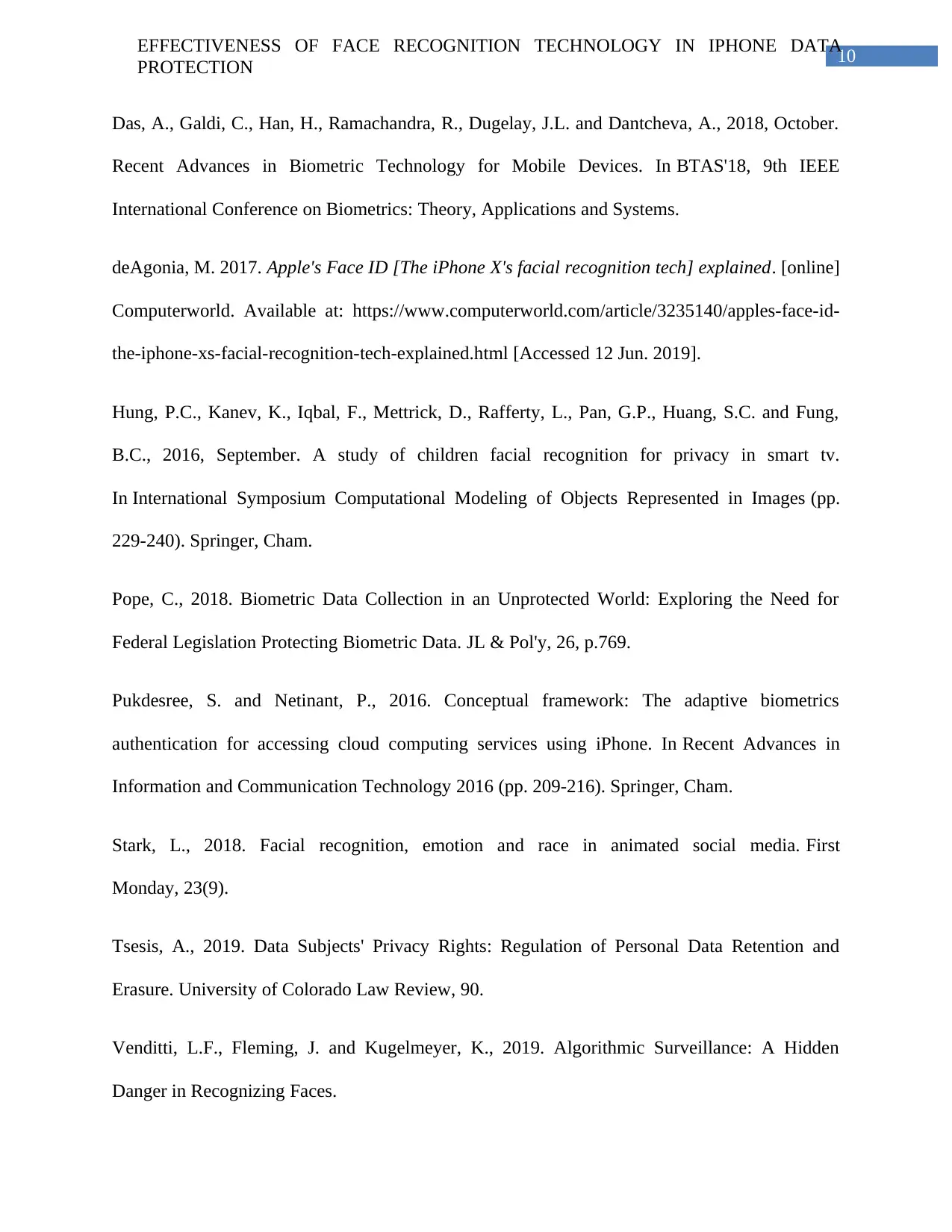
10
EFFECTIVENESS OF FACE RECOGNITION TECHNOLOGY IN IPHONE DATA
PROTECTION
Das, A., Galdi, C., Han, H., Ramachandra, R., Dugelay, J.L. and Dantcheva, A., 2018, October.
Recent Advances in Biometric Technology for Mobile Devices. In BTAS'18, 9th IEEE
International Conference on Biometrics: Theory, Applications and Systems.
deAgonia, M. 2017. Apple's Face ID [The iPhone X's facial recognition tech] explained. [online]
Computerworld. Available at: https://www.computerworld.com/article/3235140/apples-face-id-
the-iphone-xs-facial-recognition-tech-explained.html [Accessed 12 Jun. 2019].
Hung, P.C., Kanev, K., Iqbal, F., Mettrick, D., Rafferty, L., Pan, G.P., Huang, S.C. and Fung,
B.C., 2016, September. A study of children facial recognition for privacy in smart tv.
In International Symposium Computational Modeling of Objects Represented in Images (pp.
229-240). Springer, Cham.
Pope, C., 2018. Biometric Data Collection in an Unprotected World: Exploring the Need for
Federal Legislation Protecting Biometric Data. JL & Pol'y, 26, p.769.
Pukdesree, S. and Netinant, P., 2016. Conceptual framework: The adaptive biometrics
authentication for accessing cloud computing services using iPhone. In Recent Advances in
Information and Communication Technology 2016 (pp. 209-216). Springer, Cham.
Stark, L., 2018. Facial recognition, emotion and race in animated social media. First
Monday, 23(9).
Tsesis, A., 2019. Data Subjects' Privacy Rights: Regulation of Personal Data Retention and
Erasure. University of Colorado Law Review, 90.
Venditti, L.F., Fleming, J. and Kugelmeyer, K., 2019. Algorithmic Surveillance: A Hidden
Danger in Recognizing Faces.
EFFECTIVENESS OF FACE RECOGNITION TECHNOLOGY IN IPHONE DATA
PROTECTION
Das, A., Galdi, C., Han, H., Ramachandra, R., Dugelay, J.L. and Dantcheva, A., 2018, October.
Recent Advances in Biometric Technology for Mobile Devices. In BTAS'18, 9th IEEE
International Conference on Biometrics: Theory, Applications and Systems.
deAgonia, M. 2017. Apple's Face ID [The iPhone X's facial recognition tech] explained. [online]
Computerworld. Available at: https://www.computerworld.com/article/3235140/apples-face-id-
the-iphone-xs-facial-recognition-tech-explained.html [Accessed 12 Jun. 2019].
Hung, P.C., Kanev, K., Iqbal, F., Mettrick, D., Rafferty, L., Pan, G.P., Huang, S.C. and Fung,
B.C., 2016, September. A study of children facial recognition for privacy in smart tv.
In International Symposium Computational Modeling of Objects Represented in Images (pp.
229-240). Springer, Cham.
Pope, C., 2018. Biometric Data Collection in an Unprotected World: Exploring the Need for
Federal Legislation Protecting Biometric Data. JL & Pol'y, 26, p.769.
Pukdesree, S. and Netinant, P., 2016. Conceptual framework: The adaptive biometrics
authentication for accessing cloud computing services using iPhone. In Recent Advances in
Information and Communication Technology 2016 (pp. 209-216). Springer, Cham.
Stark, L., 2018. Facial recognition, emotion and race in animated social media. First
Monday, 23(9).
Tsesis, A., 2019. Data Subjects' Privacy Rights: Regulation of Personal Data Retention and
Erasure. University of Colorado Law Review, 90.
Venditti, L.F., Fleming, J. and Kugelmeyer, K., 2019. Algorithmic Surveillance: A Hidden
Danger in Recognizing Faces.

11
EFFECTIVENESS OF FACE RECOGNITION TECHNOLOGY IN IPHONE DATA
PROTECTION
Welinder, Y. and Palmer, A., 2018. Face Recognition, Real-Time Identification, and
Beyond. The Cambridge Handbook of Consumer Privacy, p.102.
Zhou, S. and Xiao, S., 2018. 3D face recognition: a survey. Human-centric Computing and
Information Sciences, 8(1), p.35.
EFFECTIVENESS OF FACE RECOGNITION TECHNOLOGY IN IPHONE DATA
PROTECTION
Welinder, Y. and Palmer, A., 2018. Face Recognition, Real-Time Identification, and
Beyond. The Cambridge Handbook of Consumer Privacy, p.102.
Zhou, S. and Xiao, S., 2018. 3D face recognition: a survey. Human-centric Computing and
Information Sciences, 8(1), p.35.
1 out of 12
Related Documents
Your All-in-One AI-Powered Toolkit for Academic Success.
+13062052269
info@desklib.com
Available 24*7 on WhatsApp / Email
![[object Object]](/_next/static/media/star-bottom.7253800d.svg)
Unlock your academic potential
© 2024 | Zucol Services PVT LTD | All rights reserved.





